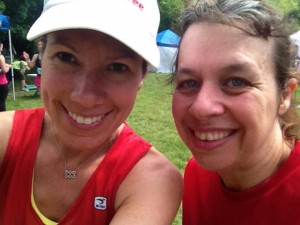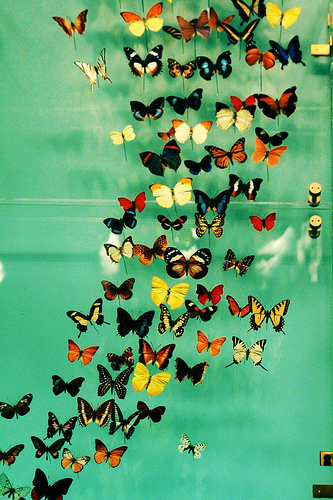I am participating in the 2012 Wordcount Blogathon, which means one post every day for the month of May.
I am always a jittery mess leading up to races, and yesterday’s Toronto Women’s Half-Marathon was no exception. If anything, I was more nervous than usual. I had trained hard, coached by my friend Phaedra, and I wanted to realize the fruits of my efforts. As I wandered around the starting area eating my pre-race peanut butter sandwich, I thought back to my season of training. Instead of thinking about all of the great runs I had, my mind stubbornly focused on the not-so-good. Like missing my very first week of training due to a stomach bug, and having to take an emergency trip to the other side of the world during my second and third week. I thought obsessively about how my training went a little pear-shaped a month ago, due to circumstances beyond my control.
I knew that these nerves would vanish as soon as the starter’s siren went off. The slight stuffiness in my nose would disappear and the tightness in my right calf would magically loosen up. I would be lifted by the collective energy of the 1500 runners around me, and I would be spurred on by my natural tendency to compete with myself.
Seeing a couple of familiar friendly faces right before the race started helped immensely. My friend George from the Geneva Centre for Autism was there to cheer on his girlfriend. Phaedra was there too, already lined up at the start. I squeezed my way into the crowded corral and waited for the siren.
And then we were off! I was forced to start at a moderate pace: this invariably happens when 1500 runners are competing for space on a narrow park trail. It is at times frustrating to be trapped behind slower runners with no immediate opportunity to pass them, but it can be enormously beneficial to be forced to keep the brakes on, particularly early in a long race.
I was aiming for an average pace of 6:30 minutes per kilometre, and for the first few kilometres, I hovered between 6:34 and 6:40. I was OK with that. Usually I increase my pace over the course of the distance, so starting slower than my goal doesn’t worry me.
The course was a challenging one. The entire race took place on park trails that at times, were barely wide enough to allow for the two-way traffic on the out-and-back segments. The trails were mostly paved, which was nice, but in places they were uneven, so I had to watch my footing very carefully. While the course was not as hilly as, say, the 10K race at the Toronto Zoo, there were enough undulations to create a challenge – most notably, the hill leading up to the bridge going over the railway line.
At about the 5K mark, I was running the out portion of an out-and-back segment, and I saw Phaedra coming towards me, running the back portion. She was looking strong and moving fast, right near the front of the pack. We cheered each other, did a high-five, and went on our way.
The kilometres ticked by. I marked the little milestones as I passed them. 7km – a third of the way there. 10.5km – halfway there. The 12km milestone is always a big one for me, because it means I only have 9K to go, and I am counting down single digits.
14km – two thirds of the way there. At this point I was really starting to hurt. A twenty-year-old ankle injury was acting up, no doubt aggravated by the uneven path. There was no way I was letting myself stop, though – I had only 7km left. 7km is like a walk in the park to me.
At 16km I hadn’t quite managed to hit my target pace, and I found myself having to revise my “A” goal of beating 2:15. I mentally shifted to my “B” goal – a personal best time. I had to beat 2:19:46 and I thought that I was only just in for a shot at accomplishing that. All I had to do was ignore the burning in my legs for half an hour or so.
18km – there are the firefighters! Sadly, none of them had their shirts off, but they were absolutely gorgeous. They were a welcome sight at a point in the race when I always start to struggle. There was no way I was going to slow down. I had to show off for the handsome firemen. I wasn’t exactly looking my best, so I had to impress them in other ways!
At 19km I saw two things: the chocolate station and Phaedra, who had finished her race and run back to meet me. I guzzled down a chocolate bar, desperately in need of the sugar rush, and then set off for the last 2km, with my friend running beside me, not letting me give up, reminding me that the prize of the finish line was just minutes away.
I was hurting, really hurting. My legs were begging me to stop, or at least slow down. Just when I thought I couldn’t take it anymore, Phaedra said, “Come on! You have five minutes left! You can do anything for five minutes!”
All of a sudden, I rounded a final bend, and there it was – the finish line. I have a strong finishing kick, and it didn’t let me down. Phaedra hopped off to the side and I charged to the finish, crossing the line in a time of 2:20:11.
I missed my personal best time by 25 seconds, but considering that my personal best time was set on a much easier course, I was satisfied with my time. I was particularly pleased that my final kilometre was by far my fastest, at 5:56.
It is worth pointing out that before Phaedra helped carry me for the last 2km, she had finished the race fourth overall, and first in her age group.
I am already looking ahead to my next half-marathon, my autism run in October. It is perhaps a good sign that as I sipped my wine and soaked my aching legs in a bubble bath last night, I was reading my copy of The Art Of Running Faster.
(Photo credit: Phaedra Kennedy)











